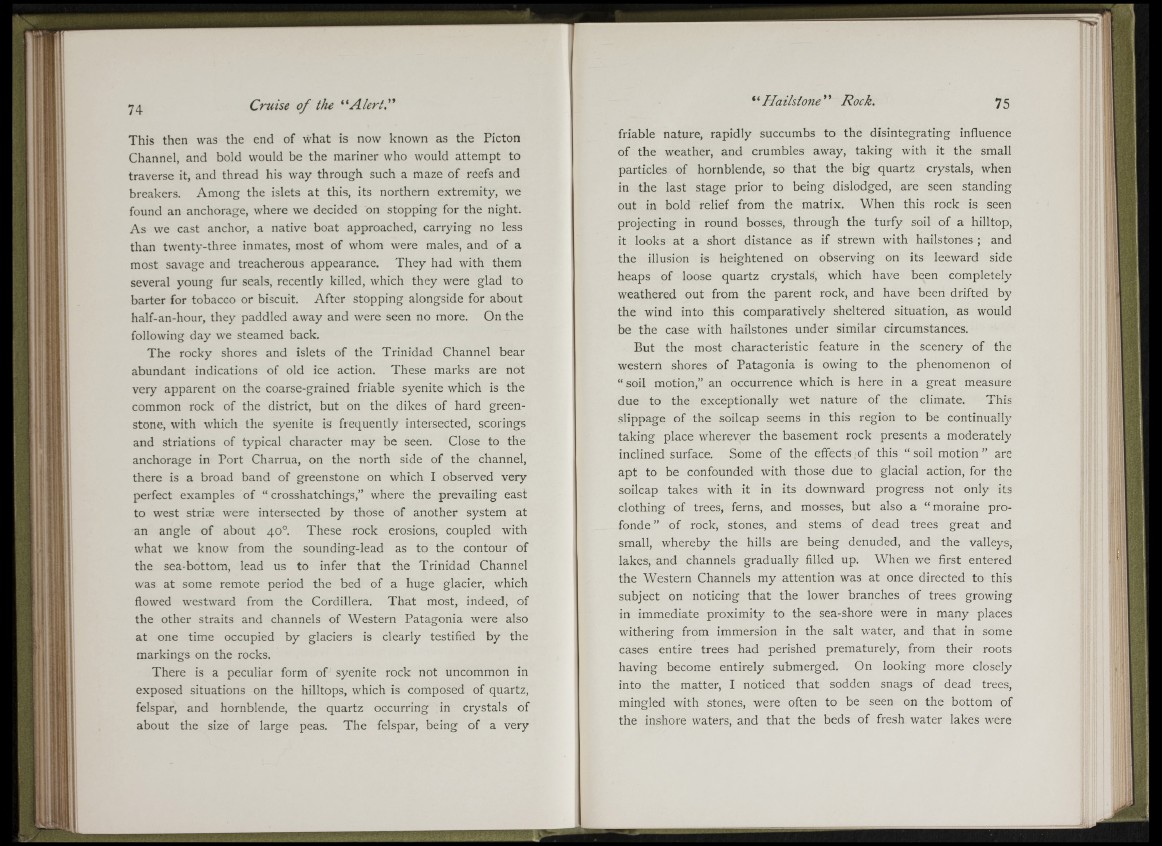
' i
m
!'"'î
U T
U h :
H i :
■;U ; i ': i! s
L l
ih) ; i
4fl {
i ,iiu i
I iiii !
This then was the end of what is now known as the Picton
Channel, and bold would be the mariner who would attempt to
traverse it, and thread his way through such a maze of reefs and
breakers. Among the islets at this, its northern extremity, we
found an anchorage, where we decided on stopping for the night.
As we cast anchor, a native boat approached, carrying no less
than twenty-three inmates, most of whom were males, and of a
most savage and treacherous appearance. They had with them
several young fur seals, recently killed, which they were glad to
barter for tobacco or biscuit. After stopping alongside for about
half-an-hour, they paddled away and were seen no more. On the
following day we steamed back.
The rocky shores and islets of the Trinidad Channel bear
abundant indications of old ice action. These marks are not
very apparent on the coarse-grained friable syenite which is the
common rock of the district, but on the dikes of hard greenstone,
with which the syenite is frequently intersected, scorings
and striations of typical character may be seen. Close to the
anchorage in Port Charrúa, on the north side of the channel,
there is a broad band of greenstone on which I observed very
perfect examples of “ crosshatchings,” where the prevailing east
to west striae were intersected by those of another system at
an angle of about 40°. These rock erosions, coupled with
what we know from the sounding-lead as to the contour of
the sea-bottom, lead us to infer that the Trinidad Channel
was at some remote period the bed of a huge glacier, which
flowed westward from the Cordillera. That most, indeed, of
the other straits and channels of Western Patagonia were also
at one time occupied by glaciers is clearly testified by the
markings on the rocks.
There is a peculiar form of syenite rock not uncommon in
exposed situations on the hilltops, which is composed of quartz,
felspar, and hornblende, the quartz occurring in crystals of
about the size of large peas. The felspar, being of a very
75
friable nature, rapidly succumbs to the disintegrating influence
of the weather, and crumbles away, taking with it the small
particles of hornblende, so that the big quartz crystals, when
in the last stage prior to being dislodged, are seen standing
out in bold relief from the matrix. When this rock is seen
projecting in round bosses, through the turfy soil of a hilltop,
it looks at a short distance as if strewn with hailstones ; and
the illusion is heightened on observing on its leeward side
heaps of loose quartz crystals, which have been completely
weathered out from the parent rock, and have been drifted by
the wind into this comparatively sheltered situation, as would
be the case with hailstones under similar circumstances.
But the most characteristic feature in the scenery of the
western shores of Patagonia is owing to the phenomenon of
“ soil motion,” an occurrence which is here in a great measure
due to the exceptionally wet nature of the climate. This
slippage of the soilcap seems in this region to be continually
taking place wherever the basement rock presents a moderately
inclined surface. Some of the effects of this “ soil motion ” arc
apt to be confounded with those due to glacial action, for the
soilcap takes with it in its downward progress not only its
clothing of trees, ferns, and mosses, but also a “ moraine profonde
” of rock, stones, and stems of dead trees great and
small, whereby the hills are being denuded, and the valleys,
lakes, and channels gradually filled up. When we first entered
the Western Channels my attention was at once directed to this
subject on noticing that the lower branches of trees growing
in immediate proximity to the sea-shore were in many places
withering from immersion in the salt water, and that in some
cases entire trees had perished prematurely, from their roots
having become entirely submerged. On looking more closely
into the matter, I noticed that sodden snags of dead trees,
mingled with stones, were often to be seen on the bottom of
the inshore waters, and that the beds of fresh water lakes were
I 'ii r
Lit
ASii